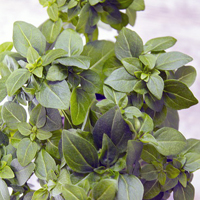Effects of different levels of mulch and irrigation on growth traits and essential oil content of basil

Accepted: 16 October 2019
HTML: 122
All claims expressed in this article are solely those of the authors and do not necessarily represent those of their affiliated organizations, or those of the publisher, the editors and the reviewers. Any product that may be evaluated in this article or claim that may be made by its manufacturer is not guaranteed or endorsed by the publisher.
Ocimum basilicum L. is an herbaceous plant from the Labiate family that used fresh, as a spice, and as a medicinal plant. Mulch is technique capable of reducing evaporation from the surface of the soil in basil production systems; it has more impacts on yield and essential oil quality of a basil crop. This research was performed in order to study the effects of different mulch types and irrigation regimes on various growth parameters and the essential oil content of basil. Treatments included two mulch types (black plastic, wood chips, and control) and three irrigation levels (100, 80, and 60% of water requirements, calculated by evaporation pan class A), following a randomised complete block design with four replications. Results showed that the effect of irrigation on fresh weight, dry weight, leaf relative water content, leaf area, and essential oil yield was significant (P<0.05). The effect of mulch on fresh weight, dry weight, leaf area, inter-node distance, number of branches, and essential oil yield was significant (P<0.05). Interaction between irrigation and mulch on inter-node distance, fresh weight, dry weight, and leaf area was significant (P<0.05). This study identified wood chips as the best mulch treatment. The highest dry weight yield (38.35 g/plant) and the highest essential oil yield (82.83 L/ha) resulted when wood chip mulch was used in combination with irrigation at 100% of the water requirement. This combination also resulted in the highest water productivity in basil production.
Highlights
- Different levels of irrigation alone did not always increase plant growth and yield of basil.
- Different levels of mulch alone did not always increase plant growth and yield of basil.
- Different levels of irrigation and mulch in combination used, increased, growth and essential oil yield of basil.
- This study identified wood chips as the best mulch treatment.
- The highest essential oil yield resulted with wood chip mulch and irrigation at 100% of the water requirement.
How to Cite
PAGEPress has chosen to apply the Creative Commons Attribution NonCommercial 4.0 International License (CC BY-NC 4.0) to all manuscripts to be published.

 https://doi.org/10.4081/ija.2020.1247
https://doi.org/10.4081/ija.2020.1247



